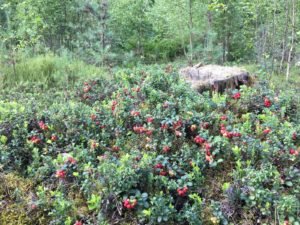Miško uogos vertingas antivirusinių medžiagų šaltinis
ieškoti: #mėlynės, #bruknės, #žemuogės, #avietės
https://pubmed.ncbi.nlm.nih.gov/24660461/ Tyrimą atliko:
Robert Krikorian 1, Marcelle D Shidler, Tiffany A Nash, Wilhelmina Kalt, Melinda R Vinqvist-Tymchuk, Barbara Shukitt-Hale, James A Joseph
Žinoma, kad įvairios miško uogų rūšys pasižymi įvairiapusėmis farmakologinėmis savybėmis.
Nuo senų senovės jos tradiciškai naudojamos dėl savo antiseptinių, antimikrobinių, kardioprotekcinių ir antioksidacinių savybių.

Šio tyrimo tikslas – atskleisti visų metanolio ekstraktų, taip pat antocianinų ir ne antocianinų, gautų iš toliau nurodytų Europoje (Bulgarijoje) nuskintų miško uogų, selektyvaus antivirusinio aktyvumo potencialą: braškių (lot. Fragaria vesca) ir aviečių (lot. Rubus idaeus) iš Rosaceae augalų šeimos bei mėlynių (lot. Vaccinium myrtillis) ir bruknių (lot. Vaccinium vitis-idaea) iš Ericaceae šeimos. Antivirusinis poveikis buvo išbandytas su virusais, kurie yra svarbūs žmogaus patogenai ir kuriems yra reikalinga chemoterapija ir (arba) chemoprofilaktika, būtent su 1 tipo poliovirusu (PV-1) ir Koksaki virusu B1 (CV-B1) iš Picornaviridae virusų šeimos, žmogaus kvėpavimo takų sincitiniu virusu A2 (HRSV-A2) iš Paramyxoviridae šeimos ir gripo virusu A/H3N2 iš Orthomyxoviridae šeimos. Miško uogos džiovinamos liofilizacijos būdu, vėliau sumalamos, tuomet ruošiami metanolio ekstraktai. Toliau ekstraktai frakcionuojami naudojant kietos fazės ekstrakciją ir ne antocianinų bei antocianinų frakcijos išplaunamos. Antivirusinis poveikis in vitro tiriamas atlikus viruso citopatinio poveikio (CPE) slopinimo testą. Rezultatai atskleidžia, kad visų ištirtų uogų ekstraktai slopina CV-B1 ir A gripo viruso replikaciją. CV-B1 labiausiai slopina mėlynės ir braškės, taip pat bruknių ekstraktai, o A gripą – mėlynių ir braškių ekstraktai. Visų miško uogų antocianino frakcijos stipriai slopina gripo A/H3N2 viruso replikaciją. Atsižvelgiant į gautus rezultatus, daroma išvada, kad miško uogų rūšys yra vertingas antivirusinių medžiagų šaltinis, o šis tyrimas turėtų būti tolesnių išsamesnių su šiuo klausimu susijusių tyrimų pagrindas.
Wildberry species are known to exhibit a wide range of pharmacological activities. They have long been traditionally applied for their antiseptic, antimicrobial, cardioprotective and antioxidant properties. The aim of the present study is to reveal the potential for selective antiviral activity of total methanol extracts, as well as that of the anthocyanins and the non-anthocyanins from the following wild berries picked in Bulgaria: strawberry (Fragaria vesca L.) and raspberry (Rubus idaeus L.) of the Rosaceae plant family, and bilberry (Vaccinium myrtillis L.) and lingonberry (Vaccinium vitis-idaea L) of the Ericaceae. The antiviral effect has been tested against viruses that are important human pathogens and for which chemotherapy and/or chemoprophylaxis is indicated, namely poliovirus type 1 (PV-1) and coxsackievirus B1 (CV-B1) from the Picornaviridae virus family, human respiratory syncytial virus A2 (HRSV-A2) from the Paramyxoviridae and influenza virus A/H3N2 of Orthomyxoviridae. Wild berry fruits are freeze-dried and ground, then total methanol extracts are prepared. Further the extracts are fractioned by solid-phase extraction and the non-anthocyanin and anthocyanin fractions are eluted. The in vitro antiviral effect is examined by the virus cytopathic effect (CPE) inhibition test. The results reveal that the total extracts of all tested berry fruits inhibit the replication of CV-B1 and influenza A virus. CV-B1 is inhibited to the highest degree by both bilberry and strawberry, as well as by lingonberry total extracts, and influenza A by bilberry and strawberry extracts. Anthocyanin fractions of all wild berries strongly inhibit the replication of influenza virus A/H3N2. Given the obtained results it is concluded that wild berry species are a valuable resource of antiviral substances and the present study should serve as a basis for further detailed research on the matter.
- PMID: 24660461
